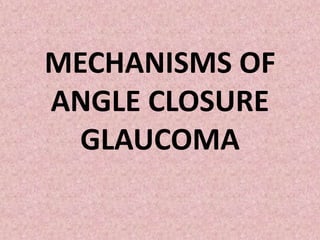
Mechanisms of angle closure glaucoma
- 4. • Of the estimated 67 million people worldwide thought to have glaucoma one third to one half have PACG • In Europeans and Africans POAG is five times more common than PACG • In Chinese, Mongolians, Indians frequency of PACG may be equal to or greater than POAG • In Eskimos/inuits prevalence of PACG higher than any other group • PACG is 2-3 times more likely to be visually disabling than POAG
- 5. • Data from India • Vellore eye study – 4.32% • Andhra pradesh eye disease study – 0.71% • Chennai eye disease incidence study – 1.58%
- 6. • Traditionally, the angle-closure glaucomas are separated into 2 main categories: primary and secondary angle closure. • In primary angle closure, there is no underlying pathology; there is only an anatomic predisposition. • In secondary angle closure, an underlying pathologic cause, such as an intumescent lens, iris neovascularization, chronic inflammation, corneal endothelial migration,or epithelial downgrowth initiates the angle closure
- 12. Risk Factors 1. Demographic factors: a. Age (> 60 years old) b. Female sex c. Chinese ethnic origin d. Family history (especially first-degree relatives, because ocular anatomic features are inherited)
- 13. 2. Anatomic factors: a. Shallow anterior chamber depth, especially peripherally ( Mean -1.8mm) b. Thick/anteriorly positioned/increased anterior curvature of lens (0.35mm/0.65mm) c. Short axial length d. Small diameter/increased curvature of cornea e. Plateau iris configuration/thick peripheral iris roll
- 14. • 3. Precipitating factors: a. Dim illumination (including extremes of temperature causing people to stay indoors) b. Drugs i. Anticholinergic agents ii. Adrenergic agents c. Emotional stress
- 15. PUPILLARY BLOCK MECHANISM • Pupillary block is the fundamental mechanism underlying the spectrum of PAC • Involves – lens iris apposition at the pupil with resultant bowing forward of peripheral iris as aqueous pressure builds up in posterior chamber • An anatomically predisposed eye that allows anterior displaced peripheral iris to block TM as
- 16. • Junction of lens and iris at pupillary plane modulates flow of aqeous from posterior to anterior chamber – Iris lens channel • Functions as a relative one way valve to sustain a minimally high pressure(0.23mm Hg) in the posterior chamber than in the anterior chamber hence directing anterior flow forward • Pupil block is a relative resistance that is present in most eyes
- 18. Whether this leads to angle closure or not depends upon: 1)baseline position of iris 2)iris stiffness 3)size of pressure differential 4)iris lens channel resistance Clinically significant pupillary block is present when increased iris convexity brings perpipheral iris into apposition with TM • Iris bombe would be expected with pressure differentials of 10-15 mmHg
- 20. PLATEAU IRIS • Barkan noticed that 20% of eyes with ACG were atypical as they had normal central ACD no iris bombe and minimal pupillary block • Schaffer and Chandler – plateau iris • Wand – two entities - plateau iris configuration and plateau iris syndrome
- 21. • Plateau iris configuration refers to an anteriorly displaced peripheral iris compromising the angle • Plateau iris syndrome refers to angle closure either spontaneously or after pharmacological dilatation in an eye with a patent iridotomy • Pseudo plateau iris syndrome – iridocliary cyst pushing the iris from behind
- 23. • Depending on the amount of obstruction that develops acute or chronic angle closure can occur • Indentation gonioscopy reveals double hump sign / sine wave sign • UBM – anterior rotation of ciliary processes • LPI / Lens extraction does not change iridociliary apposition
- 24. LOSS OF IRIS VOLUME • There is remarkable loss of iris area(10%) and volume(4%) with pupil dilatation most probably by exchange of extracellular fliud with aqueous • Quigley et al proved that eyes with ACG retained more iris volume with pupil dilatation than controls – a feature that made angle closure more likely
- 25. LENS INDUCED ACG • In this form lens moves forward excessively pushing the iris forward into anterior chamber • This subset worsens with miotics and improves with cycloplegics as they tighten the ciliary body zonular ring and move the lens posteriorly
- 26. CILIOCHOROIDAL EXPANSION SYNDROMES • In eyes predisposed to angle closure by virtue of their small dimensions , choroidal volume expansion could contribute to disease by increasing resistance in iris lens channel intensifying pupil block • Seen in choroidal hemorrhage , metastatic tumors , inflammation (uveal effusion , VKH , Panretinal photocoagulation) , Sturge weber , CCF , scleral buckling
- 27. ANTERIOR ACG • These pathologies cause initial synechial closure in contrast to most others decribed which cause appostional closure first followed by synechial closure • Examples- closure by neovascular membrane proliferating endothelial membrane (iridocorneal endothelial syndrome), by inflammatory KPs making contact with iris from the TM (sarcoidosis and chronicuveitis), etc.
